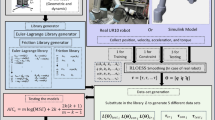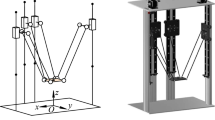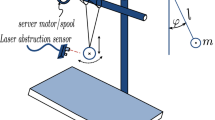Abstract
This paper reports on the kinematics of a translational parallel manipulator whose topology is close to the architecture of the famous Delta robot. The displacement analysis is presented in closed-form solution by applying a new strategy based on the unknown coordinates of a point embedded to the moving platform. The input-output equations of velocity and acceleration of the robot are systematically obtained by resorting to reciprocal-screw theory. The singularities of the mechanism are explained through the input-output equation of velocity. Finally, a numerical example is provided to show the application of the method.
Similar content being viewed by others
References
R. Clavel, Conception d’un robot parallèle rapide à 4 degrés de liberté, Ph.D. Thesis 925, EPFL, Lausanne, Switzerland (1991).
R. Clavel, Device for the Movement and Positioning of an Element in Space U.S. Patent No. 4976582 (1990).
I. Bonev, Delta parallel robot — the story of success, available in the website http://www.parallemic.org/Reviews/Review002.html.
F. Pierrot, V. Nabat, O. Company, S. Krut and P. Poignet, Optimal design of a 4-DOF parallel manipulator: From academia to industry, IEEE Trans. Robotics, 25 (2) (2009) 213–224.
L. W. Tsai, Multi-degree-of-freedom Mechanisms for Machine Tools and the Like U.S. Patent No. 5656905 (1997).
R. E. Stamper, A three degree of freedom parallel manipulator with only translational degrees of freedom, Ph.D. Dissertation, University of Maryland (1997) Ph.D. 97-4.
Glazunov V. A. Koliskor A. Sh., Krainev A. F. and Model B. I., Classification principles and analysis methods for parallel-structure spatial mechanisms, J. Mach. Manuf. Reliab., N1 (1990) 30–37.
V. Glazunov, R. Gruntovich, A. Lastochkin and N. M. Than, Representations of constraints imposed by kinematic chains of parallel mechanisms, Proc. 12th IFToMM World Congress, Besancon, France (2007) June 18–21.
S. Briot, V. Arakelian and V. Glazunov, Design and analysis of the properties of the Delta inverse robot, Proc. X International Conference on the Theory of Machines and Mechanisms, Liberec, Czech Republic (2008) 113–118.
J. Zhao, B. Li, X. Yang and H. Yu, Geometrical method to determine the reciprocal screws and applications to parallel manipulators, Robotica, 27 (2009) 929–940.
J. M. Rico and J. Duffy, An application of screw algebra to the acceleration analysis of serial chains, Mech. Mach. Theory, 31 (5) (1996) 445–457.
L.-W. Tsai, Robot analysis, the mechanics of serial and parallel manipulators, John Wiley & Sons, New York, USA (1999).
F. Pierrot, C. Reynaud and A. Fournier, Delta: A simple and efficient parallel robot, Robotica, 6 (1990) 105–109.
S. A. Joshi and L. W. Tsai, Jacobian analysis of limited-DOF parallel manipulators, Trans. ASME: J. Mech. Des., 124 (2) (2002) 254–258.
M. López M, E. Castillo, G. García and A. Bashir, Delta robot: inverse, direct, and intermediate Jacobians, Proc. IMechE Part C: J. Mechanical Engineering Science, 220 (2006) 103–109.
R. Kelaiaia, O. Company and A. Zaatri, Multiobjective optimization of a linear Delta parallel robot, Mech. Mach. Theory, 50 (2012) 159–178.
Y. Zhao, Dimensional synthesis of a three translational degrees of freedom parallel robot while considering kinematic anisotropic property, Robot. Cim-Int Manuf., 29 (2013) 169–179.
C. Gosselin and J. Angeles, Singularity analysis of closedloop kinematic chains, IEEE Trans. Robot. Autom., 6 (3) (1990) 281–290.
J. M. Rico and J. Duffy, Forward and inverse acceleration analyses of in-parallel manipulators, Trans. ASME: J. Mech. Des., 122 (3) (2000) 299–303.
R. S Ball, The theory of screws, Cambridge University Press: Cambridge (1900).
Author information
Authors and Affiliations
Corresponding author
Additional information
Recommended by Associate Editor Jong Hyeon Park
J. Gallardo-Alvarado received the B.Sc. and M.Sc. degrees in Mechanical Engineering from Instituto Tecnológico de Celaya, México, in 1985 and 1988 respectively; and the Ph.D. in electrical engineering from Instituto Tecnológico de la Laguna, México, in 1999. Dr. Gallardo is a current full time professor at the Department of Mechanical Engineering of the Instituto Tecnológico de Celaya.
A. L. Balmaceda-Santamaría graduated in Industrial Engineering from Universidad Nacional de Ingeniería (UNI) in 2009. He received the M. en T. A. from IPN — CICATA, Querétaro in 2011. Currently, his Ph.D. study is in advanced technology from IPN — CICATA, Querétaro.
E. Castillo-Castaneda received the degree of Mechanical-Electrical Engineering in 1987 from the National Autonomous University of Mexico. In 1994 he obtained the Ph.D. from Grenoble Institute of Technology, France, in Automatic Control. He is currently a professor at the National Polytechnic Institute, Mexico. His current research is related to precision engineering, computer vision, and design and control of parallel manipulators.
Rights and permissions
About this article
Cite this article
Gallardo-Alvarado, J., Balmaceda-Santamaría, A.L. & Castillo-Castaneda, E. An application of screw theory to the kinematic analysis of a Delta-type robot. J Mech Sci Technol 28, 3785–3792 (2014). https://doi.org/10.1007/s12206-014-0841-8
Received:
Revised:
Accepted:
Published:
Issue Date:
DOI: https://doi.org/10.1007/s12206-014-0841-8




